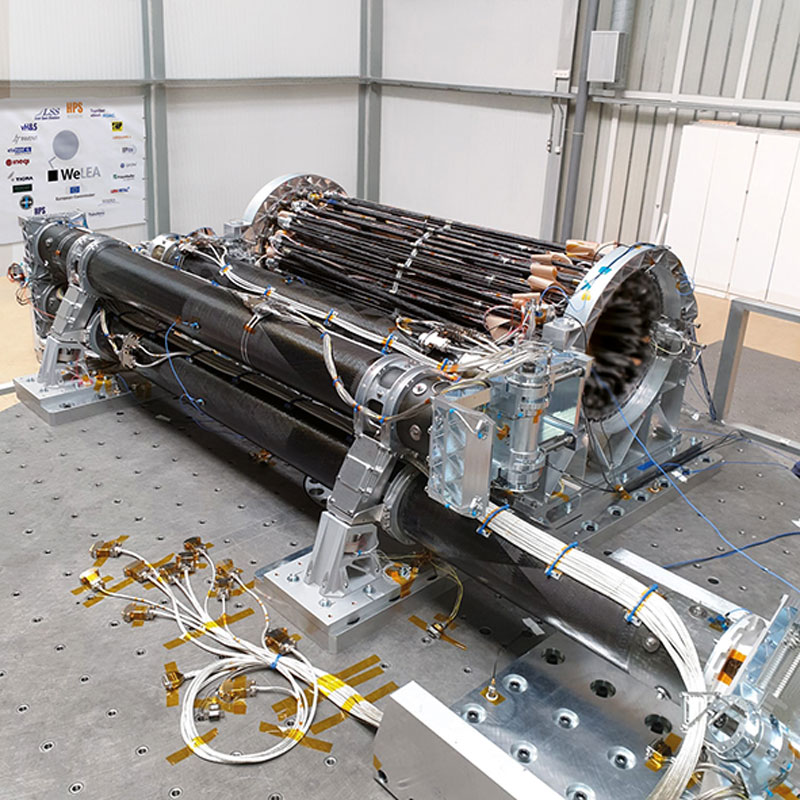CIMR-LDRS: Das Leuchtturmprojekt für Non-Dependence der europäischen Raumfahrt geht planmäßig in die Herstellungsphase des Qualifikationsmodells (EQM)
CIMR-LDRS: Das Leuchtturmprojekt für Non-Dependence der europäischen Raumfahrt geht planmäßig in die Herstellungsphase des Qualifikationsmodells (EQM)
Schon lange bevor 2022 ein unsägliches Blutbad das Ende friedvollen Lebens im Osten Europas besiegelte, hatte in der deutschen und europäischen Raumfahrt die Forderung nach technologischer „Non-Dependence“ eine Spitzenposition unter den strategischen Prioritäten erobert. Besonders im Fokus: große im Raum entfaltbare Reflektorantennen, geeignet für Missionen aller Art.
Die Geschichte dieser deutschen Technologie für Europa begann vor mehr als einem Jahrzehnt mit SCALABE, einer seitens ESA finanzierten Technologieentwicklung und SMERALDA (SME´s Radar and Large Deployable Antenna), einer von der deutschen Raumfahrtagentur finanzierten Studie mit maßgeblicher Beteiligung des Antennenspezialisten HPS GmbH. Über weitere technische Kapitel erfolgreicher Konkretisierung des Ziels mit maßgeblicher Unterstützung von ESA und EU führten die die Münchner schließlich 2020 ein Konsortium von meist mittelständischen Partnern aus acht Ländern zum spektakulären Gewinn des 115-Millionen-Euro Auftrags seitens des Prime`sThalesAlenia Space (TAS) für „CIMR LDRS“ (Large Deployable Reflector Subsystem): die größte rotierende entfaltbare Reflektorantennen-Konstruktion der Welt für das Copernicus-Leuchtturmprojekt CIMR (Copernicus Imaging Microwave Radiometer) der EU zur Beobachtung von Land, Eis und Ozeanen insbesondere der Arktis aus dem All unter dem Management der europäischen Raumfahrtagentur ESA. Das LDR-Subsystem besteht aus Reflektor, Arm, Entfaltelektronik, Verkabelung, verschieden Niederhaltemechanismen und Thermal-Hardware.
Nach langer Designphase und intensiver Iteration mit dem direkten Kunden TAS in Rom und dem Endkunden ESA erfolgte der Startschuss im Rahmen der Phase C/D durch den Abschluss des ersten so genannten „Manufacturing Readiness Review“ für Bau und Test eines Qualifizierungsmodells (Engineering Qualification Model, EQM). In diesen Tagen des Frühjahrs 2025 läutete nun HPS die intensive Phase der Herstellung des EQM endgültig ein.
Herausforderungen auf dem Weg zu neuen Ufern
Die technischen Herausforderungen waren und sind immens, denn Ziel ist kein geringeres als ein entfaltbares Reflektor-Konstrukt für hohe Frequenzen (Ka-Band) mit acht Metern Durchmesser an einem ebenfalls entfaltbaren acht Meter langen Arm, das sich im Orbit achtmal pro Minute um die eigene Achse dreht. Das resultiert in extremen Anforderungen wie etwa der eines RMS-Wertes (Root Mean Square) für die Oberflächengenauigkeit, der um einiges kleiner sein soll als 1/10 mm auf die gesamten 50 m² Reflektorfläche, oder einer erlaubten Abweichung der 8m entfernten Armspitze von maximal lediglich 10mm vom Nominalwert, Schwingungen, Zentrifugalkraft und Thermalverformungen inbegriffen.
Nicht weniger anspruchsvoll waren und sind die Herausforderungen an das Management der vielfältigen Aspekte des Projektes. Eine herausragende Rolle nimmt dabei von Anfang an die Programmleitung des CIMR-Teams der ESA und seitens TAS ein, während die für ihre Heritage im institutionellen, militärischen und kommerziellen Antennenbau bekannte HPS GmbH – neben der eigenen Entwicklungsarbeit auf Arm-und Subsystemlevel – die Führung des Konsortiums aus rund einem Dutzend KMU obliegt, darunter so herausragende Innovationstreiber wie die Münchner LSS GmbH für das entfaltbare Reflektorassembly (DRA), basierend auf einer höchst erfolgreichen, langjährigen Entwicklungspartnerschaft. Von der ehemaligen portgiesischen HPS-Tochter und heutigen FHP stammen die Leichtbau-Karbonstrebenfür das DRA, die INVENT GmbH steuert die kohlefaserverstärkten Rohre für den auf 8-Meter entfaltbaren Haltearm (DAA) bei, NanoSpace Schweiz entwickelt und produziert die hochgenauen und gleichzeitig stabilen, motorgetriebenen Gelenke des Arms, HPS-Rumänien und INEGI Portugal die Konstruktionen für Bodentests und Transporte („MGSE“). Darüber hinaus ist HPS verantwortlich für die Bereitstellung des Zentralelementes für den entfaltbaren Reflektor: das messbar beste Ka-band MESH von HPtex, das es in 9m x 9m Größe überhaupt zu kaufen gibt – und nebenbei als „made in Germany“ europäische Non-Dependence von der Vision in die Realität überführt. Denn ein MESH in solch Dimensionen gab es bis dahin nur aus amerikanischer Produktion. Ursprünglich als wesentliches Element der deutsch-europäischen Lieferkette für CIMR geplant, verkauft das 2020 gegründete Joint-Venture HPTex GmbH (JV aus Iprotex GmbH & Co. KG und HPS GmbH) mittlerweile seine Meshprodukte weltweit, insbesondere auch in asiatischen wie kontinentalamerikanischen Ländern. Das EQM-Mesh für CIMR ist kürzlich aus der HPtex-Fertigung gekommen.
Ende des Jahres stehen die wichtigsten Komponenten (DAA und DRA) bereit, die Serie der Tests beginnt früh in 2026.
„Wer vorne sein will, sollte keine Angst vor dem Unbekannten haben“ (Ernst K. Pfeiffer)
Wenn 2029 CIMR an Bord einer Vega C zu seiner Mission auf sonnensynchroner Bahn aufbricht, um jeweils von früh bis spät u.a. Eisschilde und Schnee unter Beobachtung zu nehmen, winkt Europa nicht nur der Gewinn der Erkenntnisse aus dem Projekt, sondern auch die Gewissheit, den Schritt zur technologischen LDRS-Unabhängigkeit gemeistert zu haben. LDRS sind eben auch Produkte für eine Reihe von militärischen Anwendungen, die gerade in diesen Jahren zu einer gesteigerten Verteidigungsfähigkeit beitragen können. HPS-CEO Ernst K. Pfeiffer sieht darin noch einen über den unmittelbaren Projekterfolg weit hinausreichenden Meilenstein: „Dieses Raumfahrtprojekt ist klarer Beleg dafür, dass die Mentalität aller Projekt-Beteiligten – der Industrie wie der Institutionen – eine ganz andere ist als die der Risikoscheu, welche die Öffentlichkeit vor allem Deutschland, teils auch der ESA normalerweise unterstellt. Keine Angst vor dem Unbekannten zu haben ist der erste Schlüssel zum Erfolg. Vorne ist nun mal da, wo es dunkel wird. Besonders im Weltraum. Aber eben nicht nur da.“
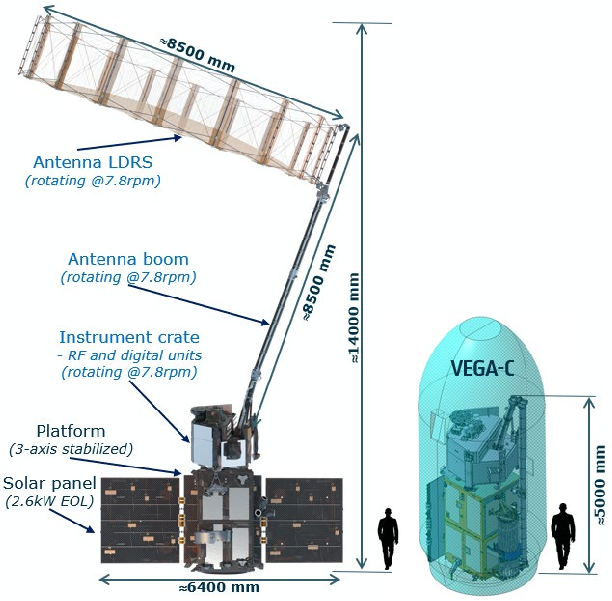
Oktober 2024
HPS Prominently Present at the IAC in Milano
Participating in the International Astronautical Congress, IAC, has developed into a good tradition at HPS over many years. This year, the company will be represented by Ernst K. Pfeiffer, CEO, together with ADEO project manager Mrs. Dorittya Milankowitch from HPS Munich and Horatiu Gheorghe as IAC-contact point for HPS Bucharest with products like secondary structures, thermal hardware and purging equipment. The HPS-team will keep up full presence during all five days of this international event.
Special highlights will be the company presentations; they are going to take place on Friday, 18th, from 10.15 to 10.45 a.m., and also as part of the Company Slam at the booth of the German association BDLI on Tuesday from 13.15 to 13.45 p.m..
Focus of both presentations will be on the product family of the ADEO deorbit sailsystem for automatic disposal of satellites after their end of mission, serving the idea of clean space, sustainability and debris avoidance even from the beginning of the satellite´s journey.
Main products besides ADEO to be asked at our booth: reflector antennas, deployable antennas, large deployable reflector subsystems, mesh, thermal hardware, purging equipment. HPS will warmly welcome there all its customers from both worlds: classic and NewSpace. For a dedicated prearranged business meeting please send a message to Contact@hps-gmbh.com.
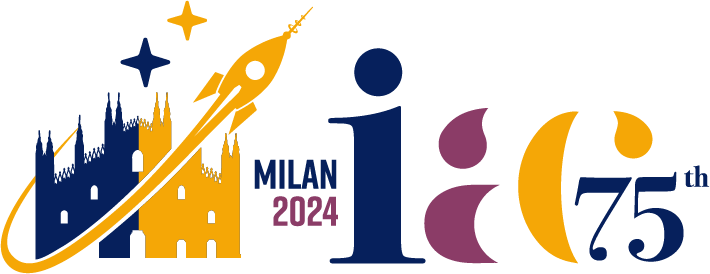
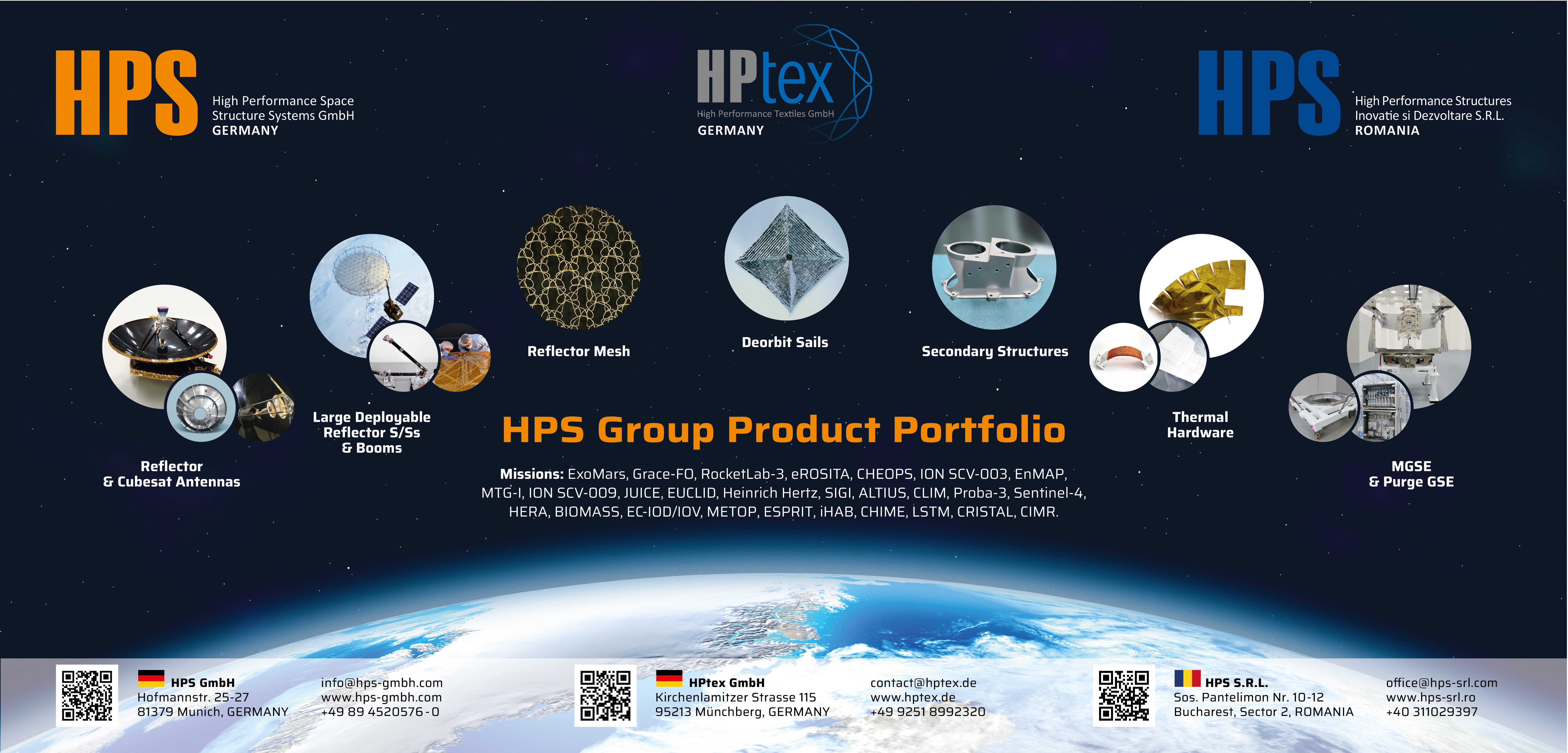
Oktober 2024
Neuartige Reflektorantenne BANT-1 von HPS für Reflex: Beispielhafte Symbiose von NewSpace und etabliertem Raumfahrt-Mittelstand
NewSpace – das bedeutet u.a. Schnelligkeit in Entwicklung, Fertigung und Bereitstellung, gepaart mit innovativer Vielseitigkeit als Leitmotiv für die Leistung des Produktes. Ein aktuelles Beispiel dafür liefert die für den neuen Satelliten von Reflex Aerospace entwickelte Reflektorantenne des Raumfahrt-Mittelständlers HPS GmbH (München, Deutschland) mit einer breitbandigen Spiralantenne als axialer Einspeisung. Primäres Entwicklungsziel war es, eine große Bandbreite sowie beträchtlichen Gain zu erreichen und gleichzeitig die Zeit von der Bestellung bis zur Übergabe an den Kunden auf lediglich 12 Monate zu begrenzen. Die Antenne besteht aus einem Prime-Focus-Reflektor mit einem Durchmesser von 700 mm und einem f/D-Verhältnis von 0,32, der von einer kompakten Ultrabreitband-Cavity-Backed-Spirale (CBS) gespeist wird.
HPS gelang damit unter Wahrung von Best Practices und striktem Qualitätsmanagement die Erfüllung aller Kundenerwartungen hinsichtlich Leistung, Preis und Timing; das Projekt ist damit ein schlagender Beleg aus der Praxis für eine beispielhafte Symbiose von NewSpace und etabliertem Raumfahrt-Mittelstand hin zu #NextSpace.
Der Satellit von Reflex startet im Rahmen der Rideshare-Mission Transporter 12 von SpaceX an Bord einer Falcon9.
Bild: Satellit „SIGI“ der Firma REFLEX AEROSPACE mit integrierter Reflektor-Antenne „BANT“, geliefert von der Firma HPS München, bereit für den Transport zum Startplatz in Amerika (links: Ernst K. Pfeiffer, CEO HPS; rechts: Walter Ballheimer, CEO REFLEX AEROSPACE, Besuch am 30.09.2024)
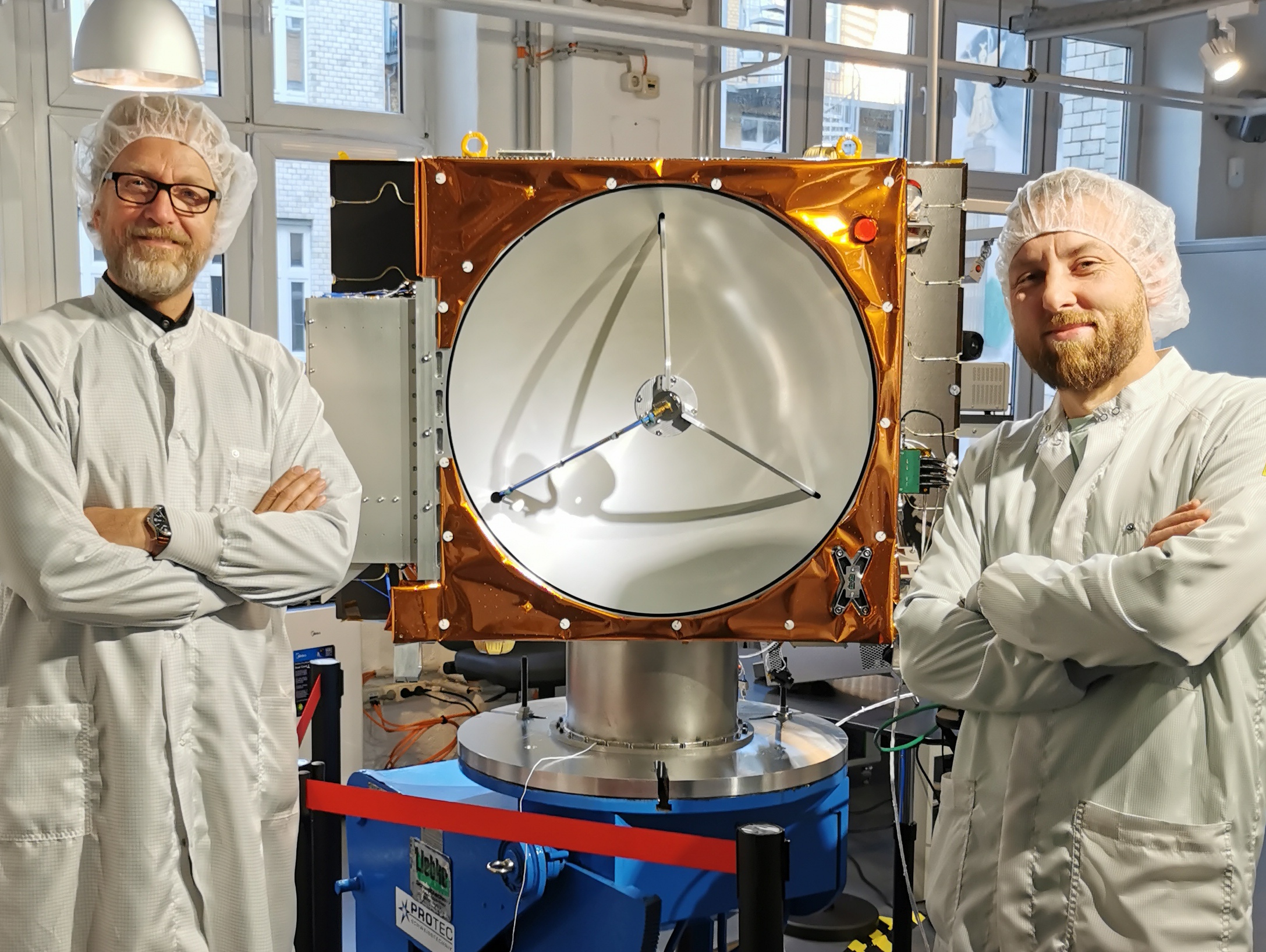
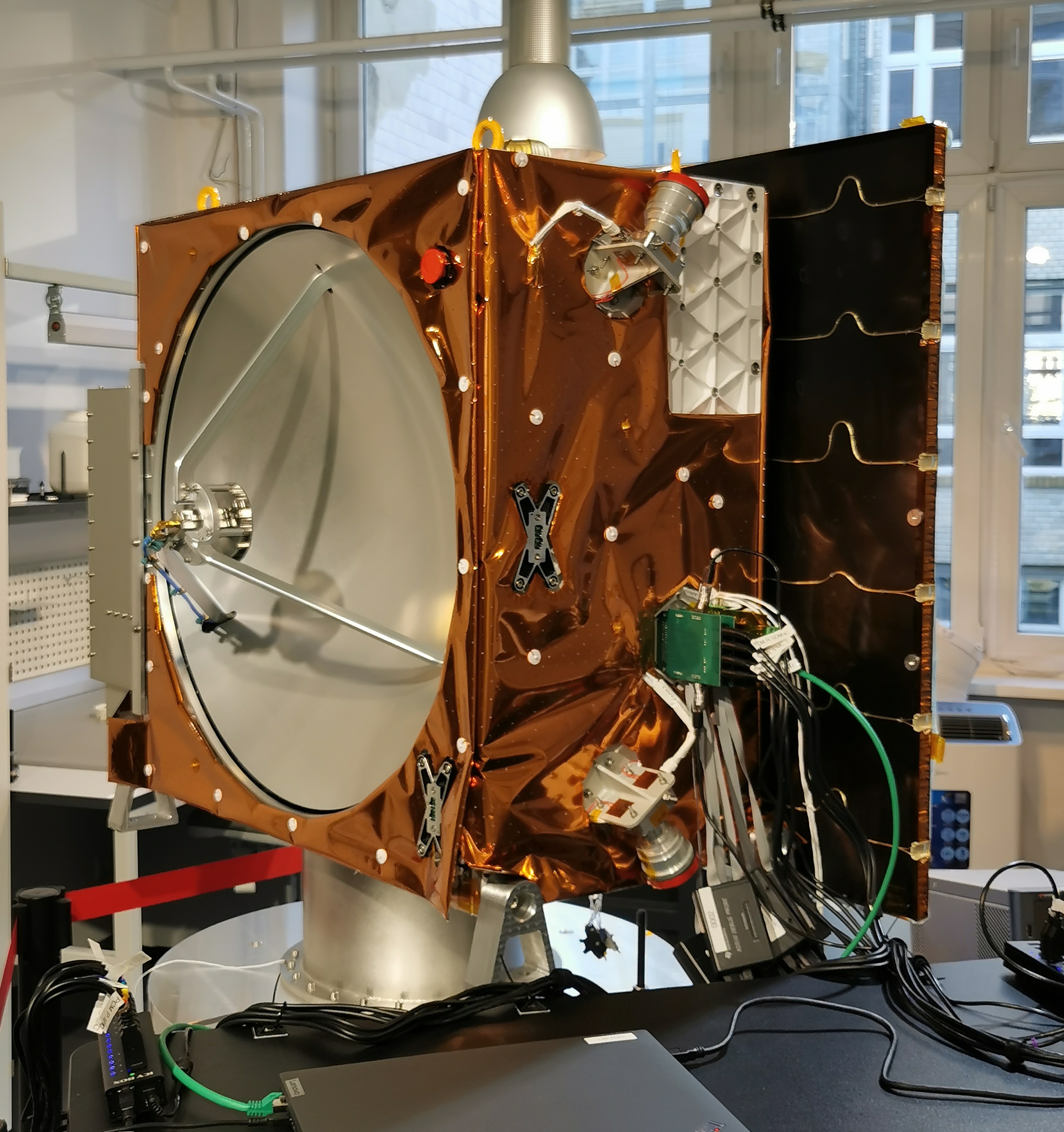
LEA-X5: New Movie on the completion of the European 5m X-band LDRS
Juli 2021
Gladly we announce with a new 20-minutes-movie the completion of the H2020-development „LEA-X5“, the 5m class European Large Deployable Reflector Subsystem (LDRS) operating in X-band.
The film itself is of course showing recent environmental and deployment tests, but it is mainly about PEOPLE, who are space engineers and space enthusiasts, and what they can achieve with combined powers and brains. These people, together with the enablers European Commission and European Space Agency, are making the achievement of „European Non-dependance“ happen.
LEA-X5 is a full LDRS-Subsystem (lead by HPS, Germany) and comprises the
- 5m diameter X-band reflector assembly (lead by LSS, Germany)
- the 5m long deployable arm assembly (lead by HPS, Germany),
- hinges & HDRMs (RUAG, DE),
- deployment electronics (vH&S, DE),
- thermal hardware (HPS/FHP).
Further partners of the H2020-consortium have been: INVENT (DE), FHP (PT), INEGI (PT), TICRA (DK), LUMA (SW), HPTEX (DE), ARQUIMEA(SP), HPS (RO), ETAMAX (DE), WSS (DE), ONERA (FR), TAS (FR), OHB (DE), Airbus (DE).
Most of the consortium members are introduced in the movie, inluding many interviews.
Take your time and enjoy the spirit of doing big things: LEA-X5 – European 5m X-band LDRS Completed (Final Report 06/2021) – YouTube
Best regards,
Your WeLEA-Consortium
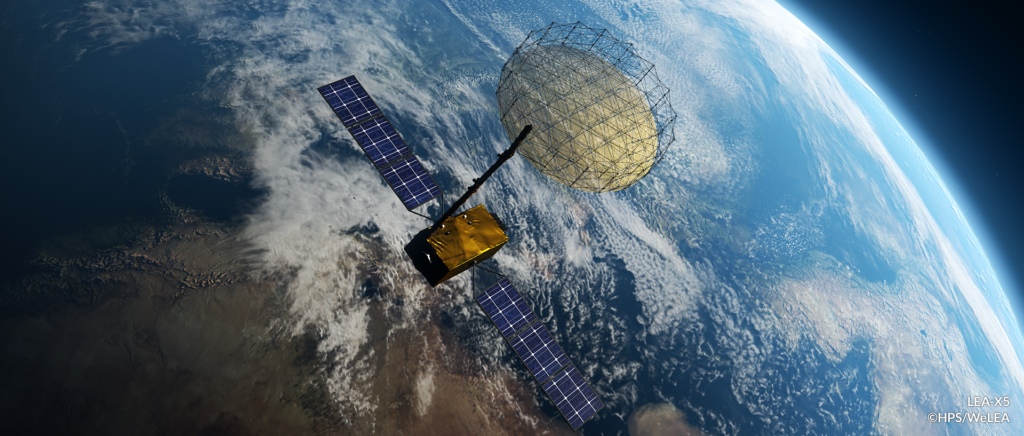
HPS announcing crucial milestone set for Europe´s own large deployable reflector subsystem (LDRS)
April 2019
Large deployable antenna reflectors are among the critical space technologies most urgently needed in Europe in order to drastically reduce the continent´s dependence on goodwill, knowhow, and supplies from the United States. Therefore, back in fall 2017 the EC decided to co-fund in the fame of its Horizon 2020-programm the 7 million € development-project LEA (Large European Antenna) of a consortium with 15 partners out of six European (D, SP, PT, SE, DK, FR) countries under the implementation leadership of HPS, Germany, among them also LSS GmbH (Germany) and RUAG Space Germany. A special cooperation between HPS and Northern Bavarian entities has already led to the development of the central component, the „European Space Mesh“; it will in future be produced in Bavaria. Now the project has taken its crucial milestone when it passed the Critical Design Review (CDR) in April 11-12, 2019, and is heading towards the final stage of its test campaign from February through August 2020. In exchange for the opportunity to gain flight heritage HPS offers the first product, LEA, for free to any customer worldwide.
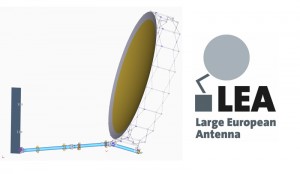
Major specs of LEA are: deployable reflector aperture at 5.1 meters with a 5.6 meter long deployable arm; a mass of just 100 kilo including reflector, arm, hold-down-and-release-mechanism, harness, thermal hardware, operating frequency: X-band. The stowed volume is as small as 2.6 x 1.2 x 0.6 meters.
This development is not only important in general, but serves also as a baseline for two potentially next Copernicus missions at the horizon with 8 and 12 meter reflector subsystems. The whole development program of LEA is based on precursors undertaken within the framework of ESA technology programs.
For more information on LEA please klick: www.welea.eu.
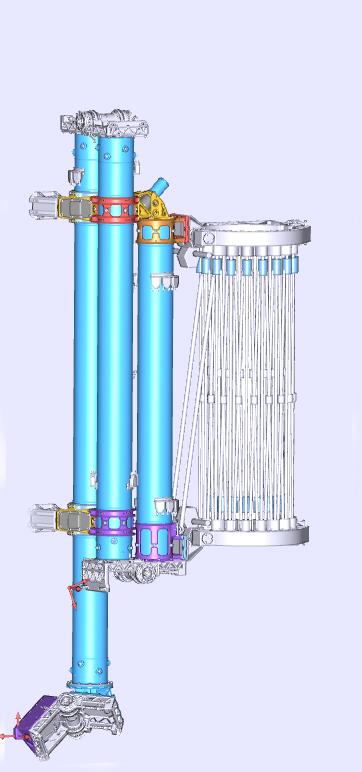
Oktober 2019
A European Declaration of Non-dependence in Space
Dear Friends and Fans of Europe in Space,
in the name of all members of our pan-European WeLEA-consortium we proudly present a video, documenting the successful road of the development of one of the most needed critical technologies in space: the Deployable Large European Antenna (LEA).
Invented, designed, tested and manufactured by more than 15 well known space companies from 7 European countries with a total staff of more than 500 dedicated specialists, representing a truly unique team of SMEs and Midcaps, the LEA-product is now taking shape as nothing less than “A European Declaration of Non-dependence in Space”.
Thanks to the farsighted vision of both powerful institutions responsible for our continent´s future in space, the European Space Agency ESA and the European Commission EC, LEA will become an invaluable technological asset to blaze our own trail towards knowledge and understanding as indispensable prerequisites to making this world a sustainable, better place – for life in diversity, for all citizens on the globe, and for one Europe across all its internal borders.
Within the WeLEA consortium HPS Germany, as prime contractor, is responsible for the project- and technical management of the whole LEA-subsystem, the deployable arm assembly and the reflective metal mesh.
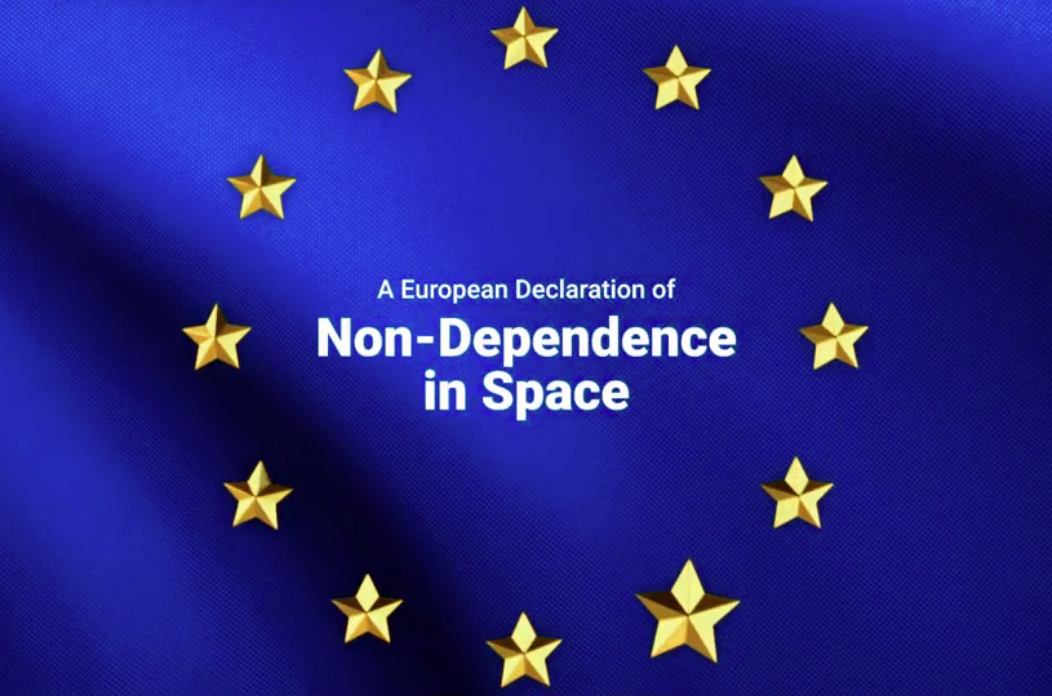
März 2021
Europas innovative entfaltbare Antennentechnologie nimmt die nächste Hürde
Mit dem soeben bei INEGI erfolgreich abgeschlossenen Test des Deployable Assembly Arm (DAA), der die Deployable Reflector Assembly (DRA) mit dem Satelliten verbindet, hat das europäische LEA-Konsortium unter der Leitung von HPS die nächste Hürde bei der technischen Realisierung von Europas neuer Antennentechnologie genommen.
Der 5 Meter lange DAA besteht aus drei Gelenkmechanismen und zwei HDRMs (beide von RUAG Space Deutschland), Auslösemechanismen (von Arquimea, Spanien), drei CFK-Rohrsegmenten (von INVENT, Deutschland), Metallbeschlägen (teilweise von HPS Rumänien) und einer Deployment Control Electronics & EGSE (von Hoerner & Sulger). Fokus der Tests war einerseits die Verifikation eines gesamten Entfaltzyklus (dauert ganze 25 min.), andererseits die Verifikation der hoher Ausrichtgenauigkeit nach der Entwfaltung, sowie die Validierung der im Vorfeld erstellten thermo-elastischen mathematischen Modelle.
INEGI (Portugal) ist der Hauptpartner für den Arm-Entfaltungstest und ein guter Partner von HPS seit nunmehr über 13 Jahren. INEGI war verantwortlich für den 0-g-Simulationsprüfstand und den thermo-elastischen Verformungsprüfstand. Trotz der Pandemie und aller Einschränkungen konnten die Teams diesen Fortschritt mit höchster Motivation und engstem Kontakt zwischen INEGI/HPS-team vor Ort in Porto und den HPS-Ingenieuren in Deutschland bewältigen. HPS ist verantwortlich für die DAA und auch für das Umsetzungsmanagement der gesamten LEA-Aktivität. Das gesamte LEA-Team umfasst 15 Partner aus 7 Ländern; das Programm startete im Rahmen von H2020 im November 2017. Der Arm-Entfaltungstest und der TED-Test (thermoelastische Verformung) war einer der letzten Tests dieser H2020-Aktivität.
Der nächste Schritt – der noch im März beginnt – ist der Umwelttest (Vibration und thermisches Vakuum) des kompletten LDR-Subsystems (Reflektor, Arm und HDRM, alles miteinander verschraubt), der bei INTA in Madrid, Spanien, durchgeführt wird.
„LEA-X5“ (5m Reflektordurchmesser, 5m Armlänge, X-Band-Anwendung für Erdbeobachtung und Telekommunikation) wird inzwischen als eine der vorbereitenden Technologieentwicklungen für die aktuelle Copernicus CIMR-Mission gesehen.

März 2021
Arm and Reflector of LEA-X5 Successfully Mated to Form Complete Subsystem
Fifteen companies – mostly SMEs – from seven countries and one goal: a deployable 5-meter X-band-antenna as a preliminary development for the CIMR project, developed under the European H2020 program (2017-2021). For the first time ever, such a complete subsystem (HPS) has now been successfully assembled in Europe from the reflector- (LSS) and arm- (HPS) assemblies. Previously, the test deployment of the arm and reflector – each individually – had already been successfully passed.
LEA-X5-Subsystem is now at the premises of the consortium´s highly reliable test partner INTA in Spain, where vibration tests for the subsystem are on the agenda in the presence of the LSS- and HPS-teams. In a third round of testing, the subsystem will have to prove itself capable of withstanding the conditions of the thermal chamber.
The next complete subsystem-hardware in this context – the CIMR LDRS-EQM – will be assembled end 2023.
With the key technology behind LEA-X5, the continent is decisively expanding its independence from non-European sources.
